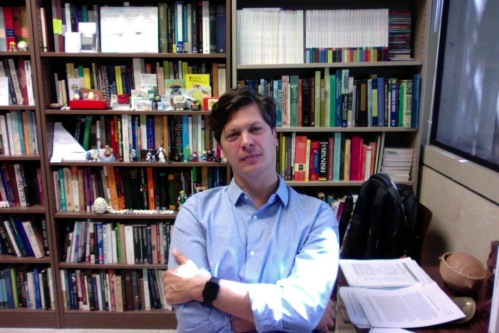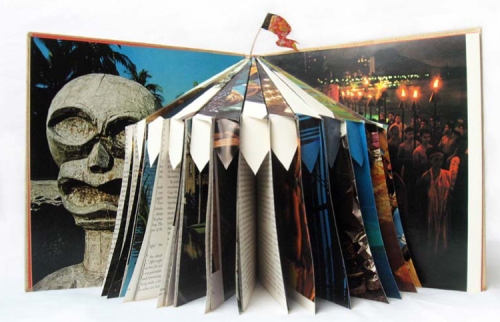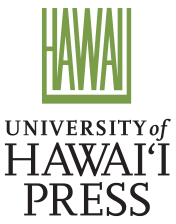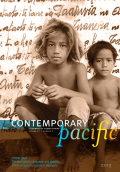Alexander Mawyer‘s passion for Pacific Island studies is contagious, and has led him to a prolific career in Hawai`i and abroad. As a graduate of the University of Hawai`i at Mānoa and the University of Chicago, he has conducted research with the Mangarevan community in the Gambier and Society Islands of French Polynesia. He has also served as coeditor of Varua Tupu: New Writing from French Polynesia and contributed a chapter for the UH Press volume At Home and in the Field: Ethnographic Encounters in Asia and the Pacific Islands. As an associate professor, he has worked on research involving the languages of Eastern Polynesia and sovereignty issues, and has served as co-director of the Biocultural Initiative of the Pacific in Oceania at UH Mānoa. With Mawyer now at the helm as editor upon its 30th anniversary, and with the launch of a new website for the journal, we asked him to share his approach to gleaning and organizing the content for The Contemporary Pacific.

What led you to become an editor in this field?
What a striking question! You make me think of Borges’s garden of forking paths, wherein stories ramify, intersect, cross over and back, and all paths turn out to have many beginnings and few, if any, evident ends . . . still a few thoughts come to mind. In the summer after college, I found myself in Honolulu and, among other things, volunteering as an editorial assistant for MĀNOA: A Pacific Journal of International Writing, which Frank Stewart and Robbie (Robert) Shapard had founded some years earlier.
Looking back, that was a serendipitous moment. Still in its first decade, I happened to be present while MĀNOA was coming into its own with growing national and international recognition. I got to know passionately committed local thinkers and writers such as Mahealani Dudoit, who founded ‘Oiwi: A Native Hawaiian Journal in 1999 and who was very often in MĀNOA’s offices in those years. I was trained as an editorial assistant and later as assistant to the managing editor by the inimitable and formidable Pat Matsueda. Frank, Pat, Mahealani, and others on the staff and around at the time were inspiring for their commitment to the ethical imagination and the transformative potential of the inked page.
At some point during my first months with MĀNOA, Frank asked me to write a review of Vilsoni Hereniko’s then freshly published Woven Gods. Vili, a professor at the Center for Pacific Islands Studies, had just edited an issue of MĀNOA dedicated to Oceanic and Pacific Islander writers and writing. At the time, this literary space was almost entirely out of view for those not themselves seizing the pen in home islands and communities. I suppose my review was not a complete disaster since Frank suggested that Vili would enjoy lunching and chatting about my review. As I discovered, Vili’s scholarly spirit expands to fill whatever space he’s in and, somehow, by the end of that lunch he had more or less talked me into doing an MA in Pacific Islands Studies.
A year later, after my MA, I moved to Chicago for my doctorate and did not imagine (and, I think, could not have imagined) that I would ever have the privilege of serving as the editor of The Contemporary Pacific. I am confident that any number of other more recent experiences could be identified as part of the story-garden for how I came to take on this editorship. But in retrospect, I’m struck by how early career experiences play out over years, by how unexpectedly paths cross and re-cross, and by how the kindness of intellectual and professional mentorship was a planting that continues to flower and bear fruit.


 About the Journal
About the Journal


 Context: Nic Maclellan reflects on the U.S.’s political influence on the Pacific region, especially as it relates to environmental regulation: “Debates over climate action, West Papua, fisheries, and trade continued as a feature of regional affairs in 2016, often dividing Pacific governments and their international partners. The election of Donald Trump as U.S. president in November set the stage for these divisions to continue, given Trump’s statements during the election campaign on climate change and America’s new directions in foreign policy.” This introduction is followed by more reports from the field, including
Context: Nic Maclellan reflects on the U.S.’s political influence on the Pacific region, especially as it relates to environmental regulation: “Debates over climate action, West Papua, fisheries, and trade continued as a feature of regional affairs in 2016, often dividing Pacific governments and their international partners. The election of Donald Trump as U.S. president in November set the stage for these divisions to continue, given Trump’s statements during the election campaign on climate change and America’s new directions in foreign policy.” This introduction is followed by more reports from the field, including  Established in 1947, the University of Hawai`i Press supports the mission of the university through the publication of books and journals of exceptional merit. The Press strives to advance knowledge through the dissemination of scholarship—new information, interpretations, methods of analysis—with a primary focus on Asian, Pacific, Hawaiian, Asian American, and global studies. It also serves the public interest by providing high-quality books, journals and resource materials of educational value on topics related to Hawai`i’s people, culture, and natural environment. Through its publications the Press seeks to stimulate public debate and educate both within and outside the classroom.
Established in 1947, the University of Hawai`i Press supports the mission of the university through the publication of books and journals of exceptional merit. The Press strives to advance knowledge through the dissemination of scholarship—new information, interpretations, methods of analysis—with a primary focus on Asian, Pacific, Hawaiian, Asian American, and global studies. It also serves the public interest by providing high-quality books, journals and resource materials of educational value on topics related to Hawai`i’s people, culture, and natural environment. Through its publications the Press seeks to stimulate public debate and educate both within and outside the classroom.







